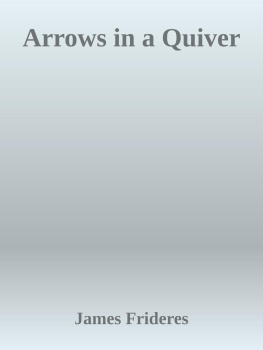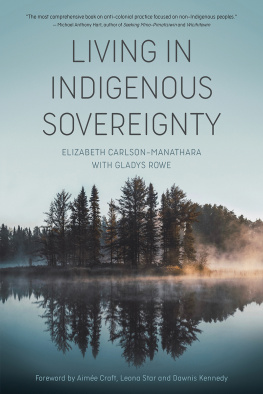Contents
Guide
Pagebreaks of the print version

Crafting an Indigenous Nation
Crafting an Indigenous Nation
Kiowa Expressive Culture in the Progressive Era
Jenny Tone-Pah-Hote
The University of North Carolina Press CHAPEL HILL
2019 The University of North Carolina Press
All rights reserved
Set in Merope Basic by Westchester Publishing Services
Manufactured in the United States of America
The University of North Carolina Press has been a member of the Green Press Initiative since 2003.
Library of Congress Cataloging-in-Publication Data
Names: Tone-Pah-Hote, Jenny, author.
Title: Crafting an indigenous nation : Kiowa expressive culture in the progressive era / Jenny Tone-Pah-Hote.
Description: Chapel Hill : University of North Carolina Press, [2019] | Includes bibliographical references and index.
Identifiers: LCCN 2018026819 | ISBN 9781469643656 (cloth : alk. paper) | ISBN 9781469643663 (pbk : alk. paper) | ISBN 9781469643670 (ebook)
Subjects: LCSH : Kiowa IndiansEthnic identity. | Kiowa IndiansSocial life and customs19th century. | Kiowa IndiansSocial life and customs20th century. | Indian artsSocial aspects. | Indian artsPolitical aspects.
Classification: LCC E 99. K 5 T 66 2019 | DDC 978.004/97492dc23 LC record available at https://lccn.loc.gov/2018026819
Cover illustration: Photograph of Massalena Ahtone, Kiowa, at the Anadarko Exposition of 1940. Courtesy of the Tartoue Negative Collection, Oklahoma Historical Society (negative 20912.14.95).
A portion of chapter 4 was previously published in a different form as We Worked and Made Beautiful Things: Kiowa Women, Material Culture, and Peoplehood, 19001939, in Tribal Worlds: Critical Studies in American Indian Nation Building , eds. Brian Hosmer and Larry Nesper (Albany: State University of New York Press, 2014), 253274. Used with permission.
To my family
Contents
Figures
Preface
I am a citizen of the Kiowa Tribe of Oklahoma, and I grew up near Orrick, Missouri, a small town near Kansas City. In Kansas City, my family participated in an urban American Indian community. Like many others, it was intertribal, and it included folks from American Indian nations in Oklahoma, individuals who stayed in the area after attending what is now Haskell Indian Nations University, and people from the reservations in the Midwest. My family and I attended American Indian events in Kansas City, danced at powwows in the area, and visited relatives in Oklahoma, often making a summer trip for the American Indian Exposition held in August in Anadarko, Oklahoma.
When I was a child, my fathers stories shaped how I imagined Oklahoma and our nation. My father, Preston Tone-Pah-Hote Sr., grew up in Anadarko and Carnegie, two major hubs of the Kiowa community, during the 1940s and 1950s. The people he told us aboutmostly our immediate and extended familyfascinated me. With my grandparents Massalena Ahtone and Murray Tone-Pah-Hote, my father and his siblings lived for a time with my great-grandparents Sam and Tah-do Ahtone in their pink house west of Carnegie near Zlt (Stinking Creek). Sam Ahtone was born in 1871, several years before the Red River War that closed one chapter of Kiowa history and ended the nomadic lifestyle of our people on the Southern Plains. Tah-do was born about a decade later, and their lives revolved around Rainy Mountain Baptist Church, where Sam Ahtone served as a deacon. He farmed and raised cattle and horses; she was a mother, cared for their home, and made beadwork. She made cradleboards for each of her grandchildren, but stopped due to failing eyesight before my father was born. Some of these cradles reside in museum collections to this day.
Their daughter Massalena Ahtone, born in 1912, married my grandfather, Murray T., born in 1911. His parents, Arts-a-paun (Joseph Tone-Pah-Hote) and Pay-yah-sape (Letty Payasape), both succumbed to tuberculosis, a disease that ripped through our family and left my grandfather, his brothers, and his sisters orphans. In 1949 Sam Ahtone passed away. A few years later the family moved to Anadarko, a larger town with more Indian people, where there was a market for the silverwork that Murray T. made. He became a well-known silversmith. My grandmother made and sold her own beadwork and helped to sell his jewelry, and they raised their children.
The lives of my grandparents and their parents reflected an important fact of Kiowa society during the early twentieth century. Those outside Indigenous communities often think that they are monolithic, with forms of cultural expression that are singularly Indian or not. But in the early twentieth century, barely a generation removed from the wars of the 1870s, Sam and Tah-do Ahtone lived in a world where many forms of cultural expression coexisted. They participated in a Christian church community. At the turn of the century, many churches stigmatized dancing, participating in the emerging Native American Church, and anything else that led away from the Jesus road. My grandmother remained a devout Christian her whole life and went to powwows, which became major community events during her lifetime. Though I knew my grandmother, Murray T. passed away years before I was born. To my knowledge, my grandfather was not a churchgoing man. In fact, my father remembered him coming to church only on Christmas Eve, a stark contrast to his in-laws, who camped at Rainy Mountain the entire week leading up to the holiday and days afterward.
What I knew of our family combined with my curiosity about some of the specific objects that simply were a part of our household. For instance, the only piece of my grandfathers silverwork I ever saw before embarking on this project sat on a bookshelf along with my parents classics Bury My Heart at Wounded Knee , Calendar History of the Kiowa Indians , one or two works by Vine Deloriaand a collection of buttons, including one that said Another Indian for Mondale. The silver piece Murray T. had made was a German silver cup. German silver is a nickel alloy and was his preferred medium. The cup had a handle and featured a warrior on horseback chasing a buffalo around the circumference of the cup. He rendered each figurethe man, the bison, and the horsein full detail.
It left me with a lot of questions. Where did this come from? Why did he make it, and what did it mean? To what extent was his art-making unusual? Or was this part of how Kiowa people remained, well, Kiowa people?
Other questions swirled around my mind as a child and would do so for decades to come. As I pondered them, I learned that the two generations of my family before my fathers witnessed and participated in major changes in Kiowa cultural lifethe coming of Christianity, the rise of the Native American Church, the emergence of powwows, and the reemergence of Kiowa military societies, just to name a few. They also witnessed the dispossession of our land, its settlement by outsiders, and the creation of Oklahoma. Along the way, they participated in a world that was full of material objects and forms of cultural expression that were rich with meaning. Tah-do Ahtones cradleboards and Murray T.s silver cup were just a glimpse into this world.
The stories about my grandparents, the objects they made, and their lives during the early twentieth century eventually generated the questions that led to this book. How did Kiowa people survive the upheavals of the early twentieth century? How did Kiowas change? To what extent did the arts change or symbolize cultural social change? What were the roles of cultural producers in this community? How did people understand the arts and their meanings?











